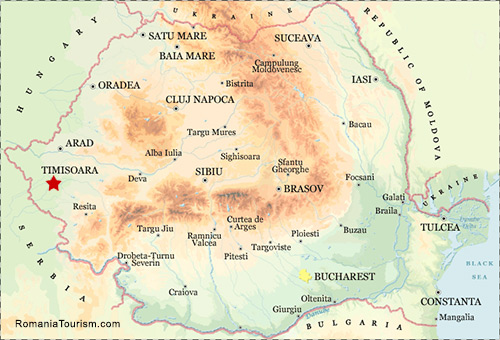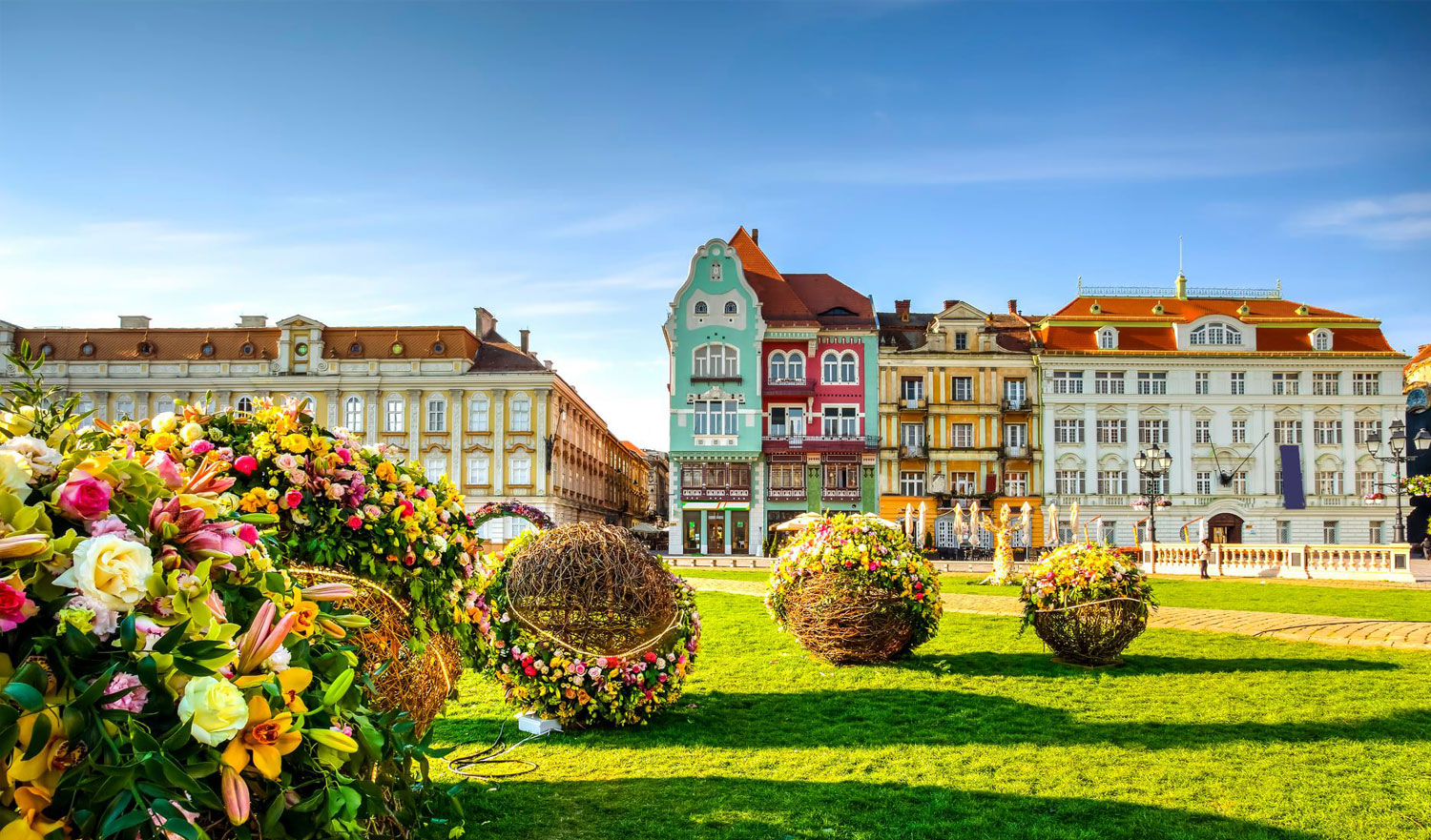
...
Timişoara Fast Facts
Name: Timişoara (Pronunced: Tee mee shoa rah)
Location: Western Romania, Banat Region
Nearest airport: Timisoara (TSR)
Area: 52 sq. miles (130.5 sq. kilometers)
Elevation: 310 ft. (90 meters)
Population: 319,500
First documented: 1019 AD
...
Timișoara Info
Timisoara, the largest city in western Romania, grew around the site of Castrum Regium Themes (Castri de Thymes), an ancient Roman crossroad fortress. Although surrounded by marshlands, in 1241, Timisoara was invaded and partially destroyed by the Tatars. In 1552, the Turkish armies conquered Timisoara and kept the town under their authority until 1716 when the region of Banat came under Austrian rule. Soon after the Habsburg Empire took over the Banat region, from the Ottomans, the new governor of Banat, General Mercy, commissioned a heptagram-shaped bastion with strong walls, towers and gates. During early 1720s large numers of Swabian immigrants settle in Timisoara. The Swabians - skilled craftsmen from Swabia, southern Germany - helped transform Timisoara in a major commercial and manufacturing town. Austrians, Germans, Jews, Serbians and Hungarians all left their mark during the two centuries of Austrian domination of Timisoara. More on history of Timisoara.
Today, artisanal chocolate manufacturer Chantia continues the city's chocolate-making tradition.
Chantia offers chocolate-lovers 40 different kinds of pralines, all made from pure cocoa butter Belgian-style chocolate.
The charm of Timisoara, a city settled on River Bega, lies in its distinct architectural character, ample green spaces and vibrant cultural life. Frequently referred to as "Little Vienna", Timisoara is home to year-round musical and theatrical performances, art galleries, museums, cosy restaurants and cafes and a buzzing nightlife.
A progressive, cosmopolitan place, Timisoara was the first city in Europe and second in the world, after New York, to use electricity to illuminate its streets.
Thanks to its mild climate, Timisoara has lots of public squares and lush green retreats.
The city is easy to explore on foot. For those to prefer to travel a little faster, a tram will be good option;
Timisoara's public transport system is fast, frequent and efficient.
Timisoara abounds with churches of several denominations, a Jewish quarter, an elegant baroque square and a pedestrian-only downtown area.
Some of the monuments in the heart of the city afford panoramic views, while the many parks in this "city of flowers"
provide an idyllic spot to take a break from sightseeing.
...
Timisoara Sights and Landmarks
The abundance of Secessionist architecture gave Timisoara its rather appropriate moniker, "Little Vienna". Secessionism developed in two distinct architectural phases in the city. Sinuous lines and floral decorations characterized the first phase which lasted until 1908. The second phase, which continued until the First World War, saw simpler, larger buildings with geometrical designs. Secessionism in Romania was an important link between the Byzantine style and later modernist architecture.
Timisoara is home to six, ample, public squares surrounded by monumental buildings. Three of them: Piata Libertatii, Piata Unirii and Piata Victoriei are located in the historic centre (Cetate neighborhood) while the other three are found in the city's main neighborhoods: Elisabetin (Piata Balcescu), Fabric ( Piata Traian ) and Iosefin ( Piata Maria ).
Piata Victoriei (Victory Square)
Some of the city's most interesting sites are its elegant baroque buildings. They can be found allover the city and around Piata Victoriei.
Piata Victoriei was created in 1906 when Timisoara medieval fortifications were demolished to create an esplanade that
stretches from Opera Piazetta to the Romanian Orthodox Mitropolitan Cathedral.
The focal point is the towering Romanian Orthodox Mitropolitan Cathedral (Catedrala Ortodoxa Mitropolitana)
that lies on the southern edge of the square. As most parts of Timișoara city-centre are built on a swamp,
5,000 oak logs were needed to support the city's emblematic structure that can accommodate 5,000 worshipers.
One of the easily recognizable features of the cathedral is its roof made of green and red ceramic tiles,
arranged in a mosaic design. In front of the Cathedral lies a memorial that remembers those who lost their lives during
the 1989 Revolution which overthrew the Communist regime. Insights into the 1989 revolution are oferred by
the Memorial Museum of the 1989 Anti-Communist Revolution (Muzeul Revoluției),
located 0.5 miles north of the cathedral. Other monumental buildings facing Piata Victoriei
include Erno Neuhausz Palace, Lloyd Palace, Weiss Palace, Merbl Palace, Dauerbach Palace, Hâlt Palace, Szechenyi Palace and Loffler Palace and the National Opera.
Piata Unirii (Union Square)
The picturesque Habsburg-era Piata Unirii is lined by imposing structures that include places of worship of different denominations, public institutions and historic pastel-hued buildings. During the 18th century, the Union Square was Timisoara's commercial centre and the venue for military ceremonies and religious processions. Piata Unirii structures of note include:
Nicolas Lenau College (Liceul Nicolas Lenau), built in 1761 and former home to the earliest theatre in Timisoara.
The Serbian Orthodox Cathedral (Catedrala Orthodoxa Sarba) completed in 1748 and the Serbian Bishop's Residence ( Vicariatul Ortodox Sarb). Its mint green and white facade with rich decorations is spectacular.
The Roman-Catholic Cathedral (Catedrala Episcopala Romano-Catolica), built between 1736 and 1754 after plans by Fisher von Erlach, the architect that profoundly influenced and shaped the tastes of the Habsburg Empire. A fine example of Viennese baroque style the Roman-Catholic Cathedral is also known for its he main altar murals, completed by Michael Angelo Unterberger, director of the Fine Arts Academy in Vienna.
The impressive 18th century Baroque Palace (Palatul Vechii Prefecturi) dominates Unirii Square's south side.
Formerly the governor's residence, Timisoara Baroque Palace now houses the Museum of Fine Arts.
One of museum's highlights is the rich colletion of works by German, Flemish and Italian artists.
At the northwest corner of Piata Unirii stands the spectacular Scont Bank (Banca de Scont).
This typical Art Nouveau structure, built in the early 20th century, features an organic shape comprising curved walls studded with turquoise tiles forming patterns drawn from folklore, and extravagant iron gutters and window grills.
From Piata Unirii, walk 0.1 milesa east along Str. Palanca to the oldest, still standing, building in Timisoara, the 18th century Maria Theresia Bastion now home of Banat Region Etnography Museum.
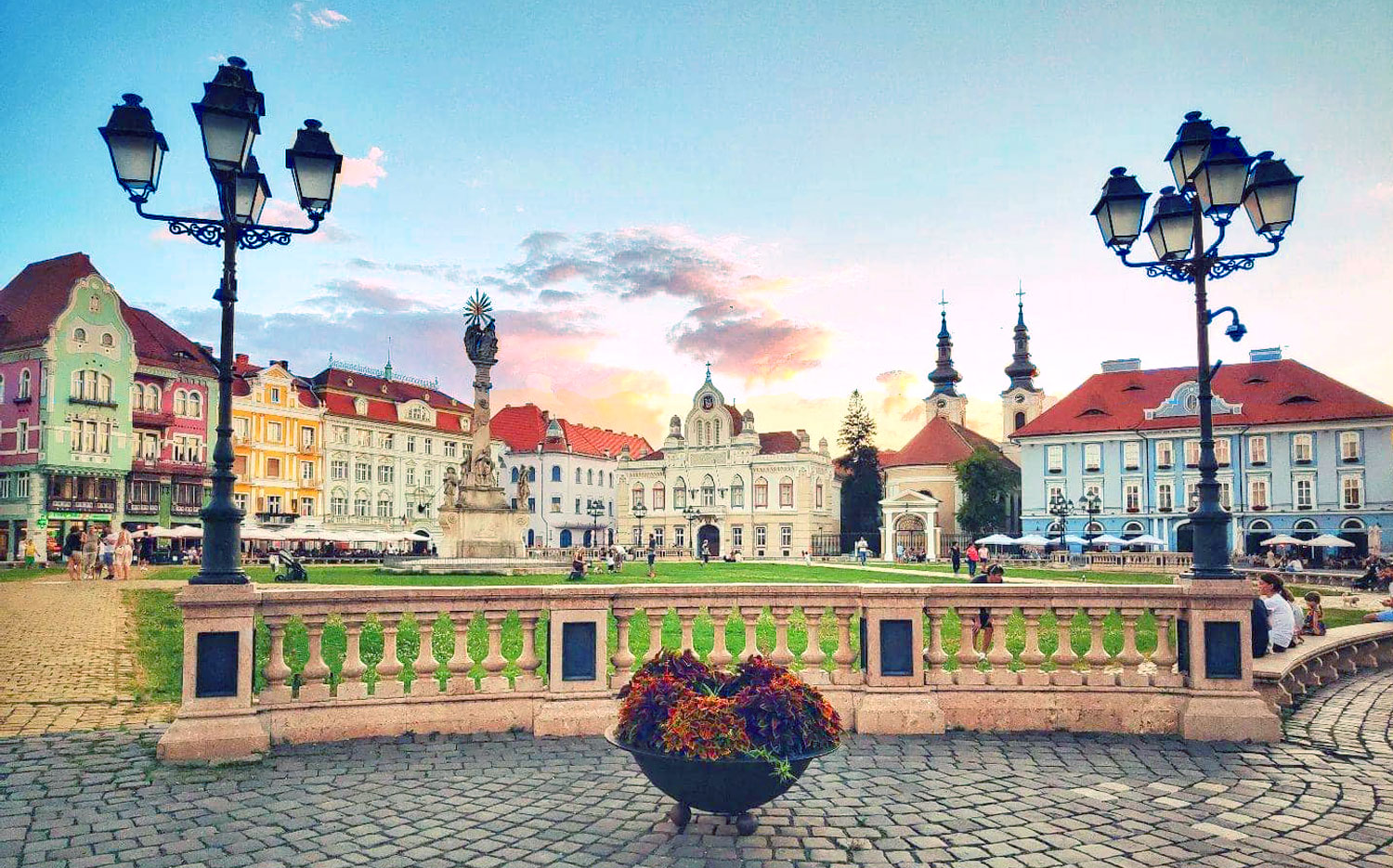
Piata Primariei Vechi / Piata Libertatii (Old Townhall Square or Freedom Square)
Another remarkable, large, square in Timisoara is Piata Libertatii, now called by the locals the Red Square.
The new name was inspired by the coloer of the tiles used to re-do the pavement in 2014.
Monumental buildings facing Timisoara Old Townhall Square include: Timisoara Garrison Headquarters, Old Townhall, Palace of Agricultural Bank, Palace of Credit Bank.
From Piata Primariei Vechi continue along Str. Lucian Blaga to the 14th century Huniade Castle (Castelul Huniade).
Built in the early 1300s, the castle was expanded in the mid-1400s and redesigned by the Habsburgs in the 18th century.
South and east of the Bega Canal are the Elisabetin, Fabric and Iosefin residential districts, true gems of Jugendstil, or art nouveau, architecture, built mainly in the late 19th century. The small residential square of Piata Plevnei, south of the Bega Canal, is bordered by excellent examples of the first phase of Secessionist architecture, such as Gemeinhardt's Peacock House (Casa cu Pauni) built in 1905. Facades are covered with an abundance of typical motifs: peacocks, swans, owls and squirrels together with sinuous vines and foliage. The theme continues on the buildings lining Splaiul Tudor Vladimirescu, following the south bank of the Bega, and to a lesser extent, around nearby Piata Maria and Bulevardul 16 Decembrie 1989.
Secessionist, or Art Nouveau architecture also can be found in the cities of Arad (especially on Strada Closca and Piata Avram Iancu), Oradea (Vulturul Negru and Astoria hotels), Cluj (Odon Lechner National Theatre), Satu Mare and Targu Mures (Palace of Culture).
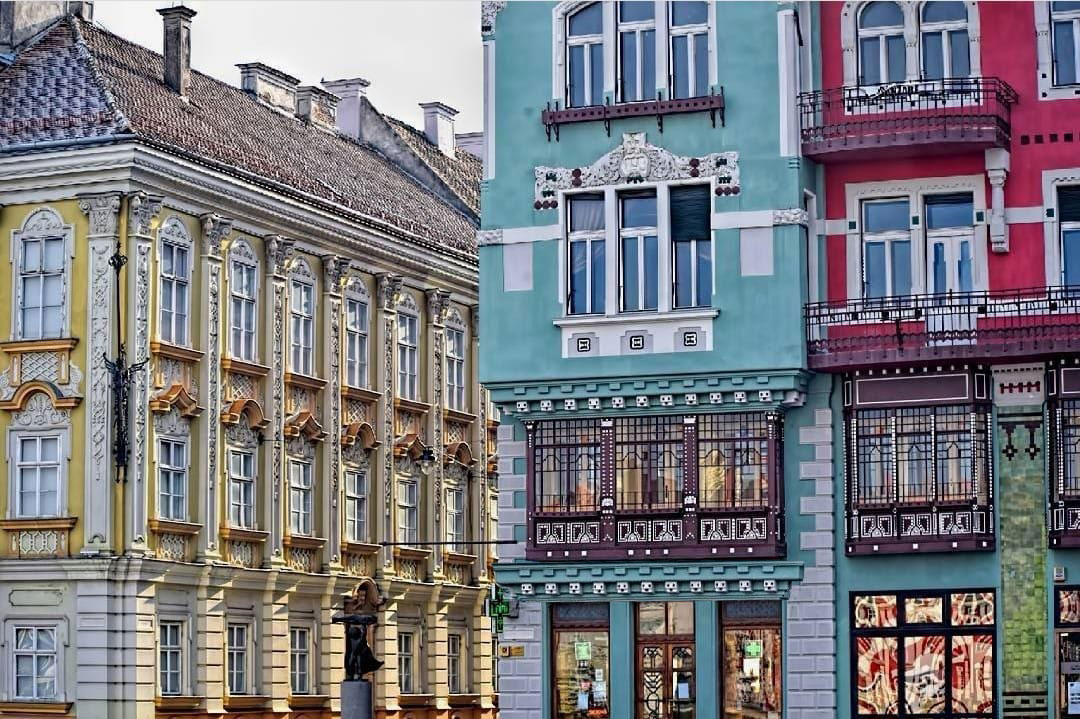
...
Jewish TimisoaraEven though Jewish presence in the Banat region dates back to the 2nd century AD,
the first written mention of the Jewish community in Timisoara occurred in 1716,
when the Turkish army commander surrendered the town to the Austrian Prince Eugeniu of Savoia.
In the old Sephardic cemetery, graves dating to the Turkish occupation may be seen, the oldest belonging to Azriel Assael,
a Rabbi and surgeon who died in 1636.
A century latter, Rabbi Meir Amigo and four followers from Istanbul were allowed to settle in the city.
Following the implementation of citizen rights acts in the Austro-Hungarian Empire,
Timisoara's Jewish community flourished, reaching a population of almost 7,000.
Six synagogues were built in the city after 1867, the year of the Austro-Hungarian reconciliation.
Today, three are still standing with one still active.
The Great Synagogue - Fabric Synagogue
Sinagoga din Fabric
Address:
Strada Ion Luca Caragiale 1
One of the most beautiful buildings in Timisoara, the Great Synagogue or Fabric district synagogue, was built in 1899 after plans by architect Lipót Baumhorn, in traditional Moorish style.
Timișoara Great Sinagogue more info .
The New Synagogue
Sinagoga Cetate
Address: Strada Mărășești 6
This Neolog-rite synagogue, built in Oriental style in 1865, resembles the great synagogue in Oran, Algeria.
One of the largest synagogues in Europe (the synagogue can accommodate up to 1,500 worshipers), it is currently closed for repairs.
Timisoara New Synagogue more info .
The Orthodox Synagogue
Sinagoga Iosefin
Address: Strada Gheorghe Pop de Băsești (Iosefin district)
Built between 1906 and 1910, the Orthodox Synagogue is the only one still in service, at this time.
Iosefin Synagogue more info .
...
Timisoara Museums
Museum of Banat RegionMuzeul Național al Banatului
Address: Piata Huniade 1
Telephone: (+4) 0256 491.339
E-mail
Open: Tue. - Sun.: 10 a.m. - 6 p.m.
Admission charge
Housed in Huniade castle (14th century), the Museum of Banat region is home to an impressive collection of historical artifacts, exhibited in five distinctive: archeology, history, natural science, technology, Lapidarium.
Muzeul Național al Banatului - Sectia de Etnografie
Address: Str. Popa Sapca 4
Telephone: (+4) 0256 491.339
Open: Tue. - Sun.: 10 a.m. - 4 p.m.
Admission charge
Exhibits of textiles, folk costumes, and glass-painted icons are on display.
Muzeul de Artă Timișoara
Address: Piața Unirii 1
Telephone: (+4) 0256 491.339
Open: Tue. - Sun.: 10 a.m. - 6 p.m.
Admission charge
The collection includes works of 15th -- 17th century Italian masters and prints by important European artists.
Muzeului Satului Bănățean - Timișoara
Address: Strada Avram Imbroane 1
Telephone: (+4) 0256 225.588
Open:
Tue. - Sat.: 9 a.m. - 5 p.m.
Sun. 10 a.m. – 6 p.m.
This open-air museum, located three miles NE from Timisoara city centre,
exhibits more than 30 traditional peasant houses dating from the 19th century.
Homes made from wood, stone and clay were taken piece by piece and set up in the beautiful surroundings of Padurea Verde(Green Forest).
Craftsmen's fairs and folk shows are held here periodically.
Muzeul Diecezei Ortodoxe Sârbesti
Address: Piata Unirii 4
Telephone: (+4) 0256 430.426
Open: Mon. - Sun.: 7:30 a.m. - 3:30 p.m.
A spectacular edifice built in mid 1700s,
the seat of the Serbian Orthodox Episcopate of Timisoara is home
to a rich art collection that includes paintings and outstanding 18th century icons.
Muzeul Consumatorului Comunist
Address: Str. Arhitect Laszlo Szekely 1
Telephone: (+4) 0724 592.379
Open:
Mon. - Fri. 10 a.m. – 11 p.m.
Sat. 11 p.m. – 11 p.m.
Sun. 2 p.m. – 11 p.m.
Admission is free, donations appreciated
Products available for purchase in Romanian stores and household items are displayed in a ‘Communist Times’ typical apartment.
This is a privately owned museum.
Muzeul Uneltelor
Address: Str. Divizia 9 Cavalerie nr. 49A
E-mail
Over 20,000 tools and instruments used in different trades.
This is a privately owned museum.
Muzeul Revolutiei
Address: Str. Emanuil Ungureanu 8
Telephone: (+4) 0256 294.936
Open: Mon. - Sun.: 9 a.m. - 5 p.m.
Free admission
The Memorial Museum exhibits photographs, written testimonies of witnesses and participants in the Revolution,
personal documents, an audio-visual archive, a library and a collection of newspapers uniforms of Romanian militia and military.
A video charting the rise and fall of Nicolae and Elena Ceausescu can be shown on request.
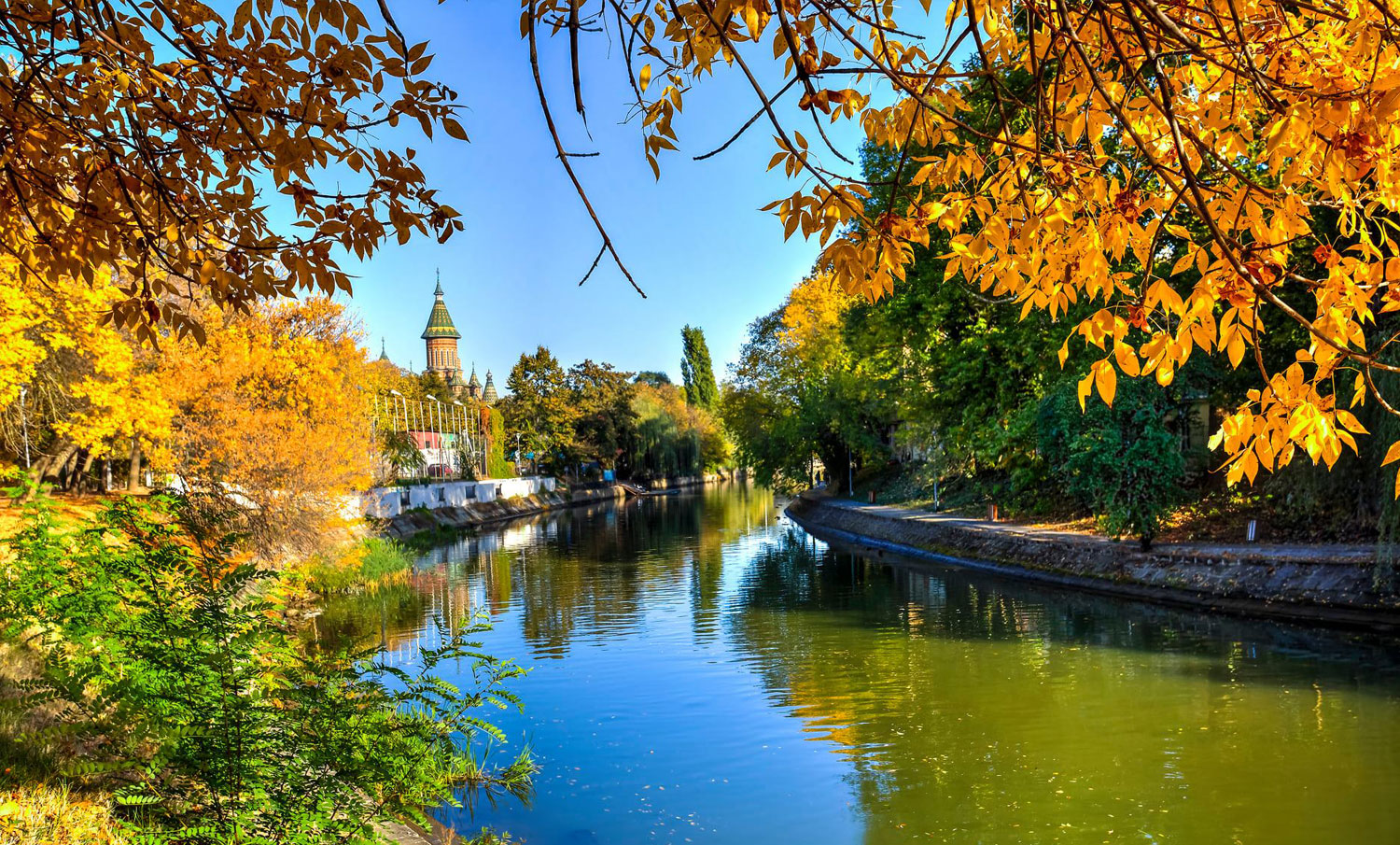
...
Performing Arts
Symphonic Music
Banat Philharmonic
Filarmonica de Stat Banatul
Address: Blvd. C.D. Loga 2
Telephone: (+4) 0256 495.012
Opera & Ballet
Romanian Opera House
Opera Națională Română Timișoara
Address: Str. Marasesti 2
Telephone: (+4) 0256 201.286
The construction of the Romanian Opera House, began in 1871 and ended four years later.
It was designed by Viennese architects, Helmer and Fellner who have also helped build concert halls in Budapest, Vienna and Odessa.
The murals in the concert hall are inspired by history and popular Romanian fairytales.
Opera in Timisoara was appreciated as far back as the end of the 18th century.
Joseph Strauss started out as Musical Director at Timisoara,
where he composed and presented the world premiere of Faust's Life and Deeds.
Franz Liszt also performed in Timisoara in 1846.
Drama Theatre
Timișoara National Theatre
Teatrul Național Timișoara
Address: Str. Marasesti
Telephone: (+4) 0256 201.288
German State Theatre
Teatrul German de Stat
Address: Str. Marasesti 2
Telephone: (+4) 0256 201.291
Hungarian State Theatre
Teatrul Maghiar de Stat Csiky Gergely
Address: Str. Alba Iulia 2
Telephone: (+4) 0256 134.814
Timișoara Puppet Theatre
Teatrul pentru copii si tineret "Merlin"
Address: Blvd. Tineretii 3
Telephone: (+4) 0256 493.049
...
Timisoara Festivals and Events
Major Timișoara festivals and events include:
International Salsa Dance Festival “Salsa with Attitude” (March),
Timișoara Flower Show “TimFloralis” (May),
International Short Films Festival “TresCourt” (June),
Timisoara International Jazz Festival “JazzX” (July),
Timisoara International Festival of Folklore “Festival of the Hearts” (July),
Timisoara International Film Festival “Ceau, Cinema” (July),
Timișoara Opera and Operetta Festival (August),
Timisoara Christmas Market (December)
A compilation of Romania’s main events is available in Romania Events section
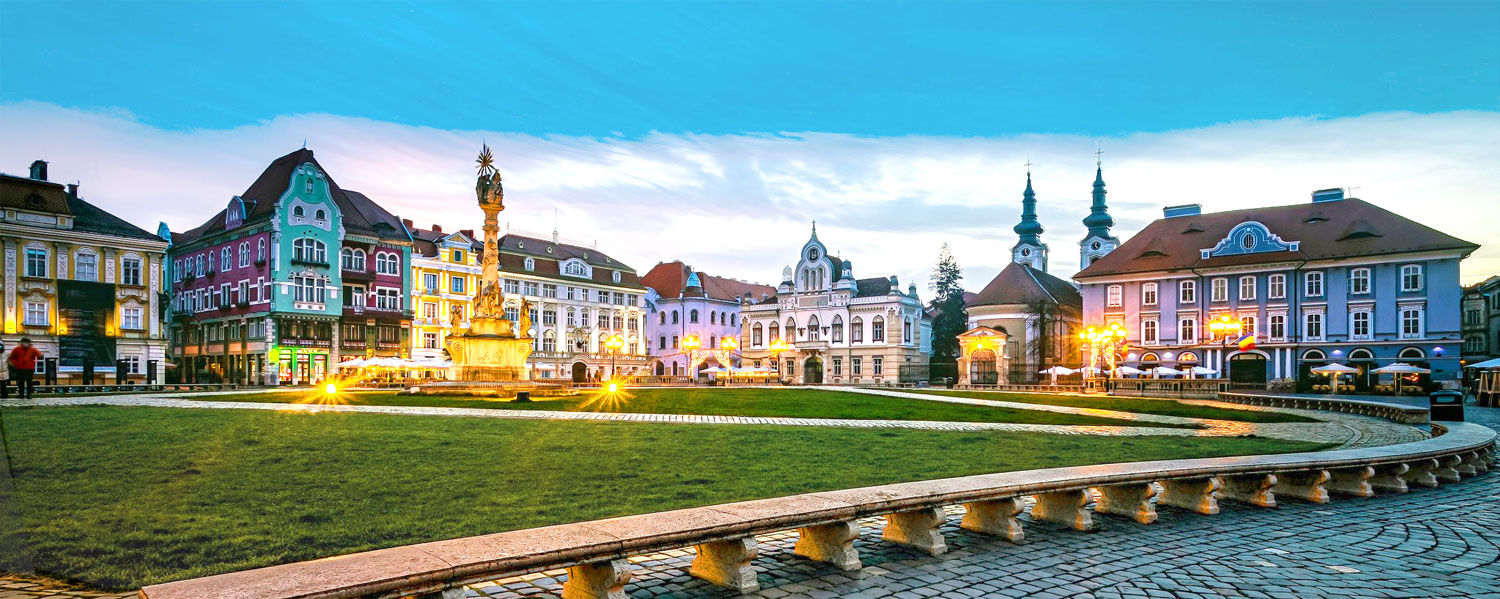
...
Timisoara History
200 BCArcheological remains attest the presence of a population of farmers, hunters and artisans in Timisoara area. The first identifiable civilisation in Banat region (western Romania) were the Dacians who left traces of their past; historians believe that the current location of Timișoara corresponds to the Dacian settlement of Zurobara. (coordinates given by geographer Ptolemy in Geographike Hyphegesis place Timisoara in the northwest of Banat).
9th century
Voivode Glad rules over Banat. Glad is one of the three dukes who ruled territories inhabited by Romanians, at the time of the Hungarian invasion.
11th century
A fortification built for the surveillance of forests and roads.
1212
First mention of Timișoara in a written document: Roman castrum Temesiensis or castrum regium Themes
The name Timisoara comes from Castri de Thymes which kept the old Daco-Roman name of the Timis river.
1241 century
Timisoara is destroyed by the Tatars, but citadel was soon rebuilt.
1307
Timisoara fortress is strengthened with stone walls and a royal palace is built. Timișoara's importance grows due to its strategic location, which facilitated control over the Banat plain.
14th century
Timişoara - a fortress in the middle of marshland - becomes the forefront of Western Christendom's battle against the Muslim Ottoman Turks.
1440
Ioan de Hunedoara (John Hunyadi ) - known throughout the region for his victory in Belgrade over the Ottomans - is appointed Count of Timiș and moved with his family to Timișoara. Timisoara becomes a permanent military camp. Fortress remained in the possession of the Corvins until 1490.
April 22, 1552
A strong Ottoman army conquers Timisoara; the city becomes the capital city of the region (Eyalet of Temeşvar).
The fortress is used as a strategic starting point for the military campaigns.
For 164 years, Timisoara remains under Ottoman rule, being under the direct control of the Sultan and having a special status, like that of Belgrade or Budapest.
August 5, 1716
The Austrian army led by Prince Eugene of Savoy attacks Timișoara.
Ottoman military and the Turkish civilian population leave the city after a 48-day siege marked by repeated bombings that destroyed much of the city's buildings.
1718
Region Banat of Temeswar becomes a province of the Habsburg monarchy and is proclaimed "possession of the Crown".
Early 18th century
German Catholics from Württemberg, Swabia, Nassau, are invited to settle in Banat; Germans that colonized Banat would become known as Banat Swabians.
Although Swabians that settled in Timisoara strongly developed craftsmanship, the main function of Timișoara during this period was that of a military fortress.
The existing fortifications are rebuilt and expanded.
1732
River Bega is regulated and becomes a navigable canal.
1765
Timisoara it considered one of the four main cities of the Habsburg monarchy.
1781
Joseph II, ruler of the Habsburg monarchy, declares Timișoara a "free royal city" - a status that secured Timișoara’s internal self-government, the right to have representatives in the Diet and that of disposing its own revenues.
1848
The Hungarians siege Timisoara for 107 days in an unsuccessful attempt to capture the city.
1848 to 1860
Timisoara serves as capital of Serbian Vojvodina and the Voivodeship of Serbia and Banat of Temeschwar which became a crownland of the Austrian Empire.
Designated as the residence of the governor, Timisoara maintained all its privileges of a free royal city.
1860
The Voivodeship of Serbia and Banat of Temeschwar was abolished and most of its territory was incorporated into the Habsburg Kingdom of Hungary.
1867
Direct Hungarian rule began, following the Austro-Hungarian Compromise of 1867 / establishment of the dual monarchy.
End of the 19th century
Timisoara experiences extensive modernization and fast economic and demographic growth.
Former bastions and military structures are demolished and replaced with urban developments.
1892
Emperor Franz Joseph I decides to abolish the fortress status of Timișoara.
1899
Demolition of the fortifications begins and the main function of Timisoara becomes economic.
October 31, 1918
Supported by representatives of the region's main ethnic groups: Germans, Hungarians, Romanians and Serbians, local military and political elites establish the Banat (Region) National Council.
November 1, 1918
Banat Republic is proclaimed. However, in the aftermath of World War I, the Banat region was divided between the Kingdom of Romania and the Kingdom of Serbs, Croats and Slovenes. Timișoara comes under Romanian administration.
1920
King Ferdinand I of Romania awards Timișoara the status of a University Centre.
Early 1920's -- early 1940's
Timisoara becomes one of the most dynamic cities in Romania; city's economy and culture flourish.
August – September 1944
German and Hungarian troops attempt, unsuccessfully, to take Timisoara by force.
Late 1940s – late 1980s
Timișoara undergoes Sovietisation and Systematisation. The city becomes one of Romania’s main manufacturing centres, both through new investments and by increasing the capacities of the old enterprises.
December 15–17, 1989
Ample antigovernment demonstrations erupt in Timișoara.
December 20, 1989
Timișoara is declared the first city free of Communism in Romania. Protests spread allover Romania and on December 22, 1989, communist leader Nicolae Ceaușescu is removed from power.
...
Attractions not far from Timisoara
Recaș WineryCramele Recaș
Where: 12 miles east of Timisoara
Access: car, bus, train
White, red and rosé wines obtained from Cabernet Sauvignon, Burgund Mare, Merlot, Cadarca, Feteasca Regala or Creata grapes
are offered at Recas Wine Cellars.
A visit at the cellars will give you the opportunity to attend a presentation of the wine making process in the Barrique Hall,
and the conservation of bottled wines in the Recas vinoteque - featuring stocks of exceptional vintages.
Where: 12 miles northwest of Timișoara
Access: car, bus
305 acres of protected land are home to 210 species of birds.
The little egret (Egretta garzetta), the great white heron (Ardea Alba), the yellow heron, the little cormorant (Microcarbo Niger)
and the black-winged stilt (Himantopus Himantopus).
Best time to visit: April through September
Where: 28 miles NE of Timisoara
The story of Charlottenburg begins in 1771 when count Aldringen, the Governor of the region of Banat (western Romania)
invited 32 families of Swabians (German etnics from SW Germany) to settle in the area.
Historians believe that the village was named after Governor's wife Charlotte.
Charlottenburg is the only village in Romania with homes laid out around a central plaza in the shape of a circle
("circular village"). The circle is a universal symbol for unity, the absolute, the perfect.
In 1890, count Siegfried Graf von Wimpffen built in Charlottensburg a hunting lodge,
populated the nearby forests with red deer from Austria and Bohemia, and transformed it in a hunting reserve, the oldest in Romania.
Today, the hunting lodge is home to Charlottenburg Hunting Museum.
Nearby accommodations include Casa Altringen,
a great place to sample local gastronomy and explore the area.
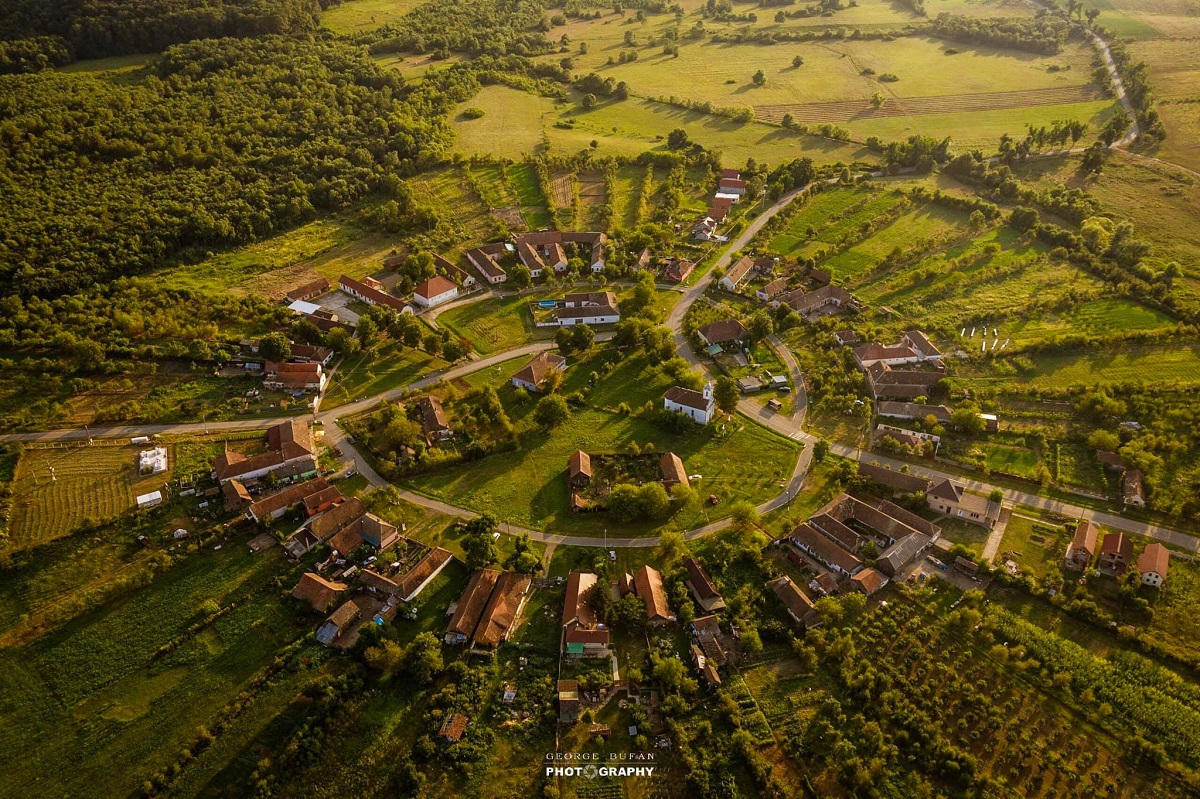
Where: 22 miles east of Timisoara
Access: car, bus, train
Town of Buzias is known for its mineral waters and pure naturally ionized air.
Designated as a Balneal Town, in 1819, Buzias is home to several medical spas that alleviate rheumatism and other bone and muscle disorders.
This unique 1,650 feet-long covered promedade was built in 1875 for Empress Elisabeth of Austria (Sissi), a frequent visitor to Buzias. It connects the former Casino, several mineral water springs, hotels and the bazaar.
Two miles south of Buzias Dealurile Silagiului winery offers visitors the opportunity to try fine wines obtained from Cabernet Sauvignon, Italian Riesling, Muscat Ottonel, Pinot Noir and Sauvignon Blanc grapes.
...
Day Trips from Timisoara
City of AradWhere: 30 miles north of Timisoara
Access: car, bus, train
Arad info
Where: east of Timisoara, 235 miles roundtrip
Transportation: car
Leave Timișoara and head east to the town of Lugoj, founded on the site of a Roman fortified camp.
Visit Old Town Lugoj, home to numerous structures built in mid-1700s, including the Orthodox Church of the Assumption,
one of the most representative baroque buildings in Banat region.
Continue southeast to Colt fortress (mid-1300s),a stronghold founded by regional ruler Cândea.
To keep his properties and titles of nobility, Cândea had to change his name to Kendeffy and convert to Catholicism).
"The Castle in the Carpathians" (Castelul din Carpați).
Action of other two novels by Verne take place in Romania: "The Danube Pilot" and "The Stuborn Keraban".
Next, cross the Carpathians into Transylvania and stop by at Densus, where you can find one of the oldest Romanian churches.
This monument was built in stonein the 13th century; some historians assume Densus is in fact a re-shaped Roman mausoleum.
Build from river rocks, bricks with Roman inscriptions and funerary stones, the Saint Nicholas Church at Densus
makes for an interesting visit.
Couple of miles east, climb up to the ruins of Colți fortress* in Suseni.
From up here enjoy a spectacular view over the rugged peaks and ridges of the Retezat Mountains.
Castelul Corvinilor - Hunedoara
Where: 105 miles east of Timisoara
Access: car, bus, train
Drive from Timisoara to Hunedoara, over picturesque hills with secluded villages.
During the 14th and 15th centuries, Hunedoara was Transylvania's main iron extraction and processing centres.
The swords and spears manufactured here during this period were renowned across Europe.
The town is home to the mighty 15th century Corvin Castle (Castelul Corvinilor),
one of the finest examples of gothic architecture in Central and Eastern Europe.
Corvin Castle more info
The region around Hunedoara was one of the earliest settled parts of Romania. Deep in the mountains above Orastie lay Neolithic remains and vestiges of the Dacian citadels, including Sarmizegetusa Fortress (UNESCO World Heritage Site), seat of kings Burebista and Decebal. The former Dacian capital was conquered by the Romans in 106 AD. Today visitors can still admire remnants of the forum and the stone amphitheatre, where gladiator shows were held.
Just west of Hunedoara, Woodlanders' Country (Ținutul Pădurenilor - 22 villages that have succeeded to preserve their century-old traditional dress and folklore) await visitors.
Retezat Mountains National ParkParcul Național Retezat
Where: 130 miles east of Timișoara
Access: car, bus
Retezat National Park Info
Set amid one of Romania's most beautiful mountain ranges,
Retezat National Park claims some of the highest mountain peaks in Romania (Retezatu and Peleagu, both more than 8,200 ft. high).
The area is dotted with over 80 clear glacial lakes, numerous trekking trails and abundant wildlife.
A hiker's dream, Retezat became Romanian's first national park a biosphere reserve, in 1935.
Baile Herculane
Where: 100 miles southeast of Timișoara
Access: car, bus, train
Herculane is, arguably, one of oldest thermal baths town in the world.
Legend says that Hercules cured the wounds inflicted by the Hydra by bathing in the mineral springs of this area.
Established by the Romans at the beginning of the 2nd century A.D., Herculane was first documented in 153 A.D.
Starting in 1736 the town and ancient thermal baths were rebuilt
under the personal supervision of the Governor of Banat region, general Andreeas Hamilton.
Many of the mid-1800s structures in Herculane - fine examples of Baroque and Transylvanian-Baroque architecture - are still standing,
though some in immediate need of restoration.
The town welcomed notable guests including Roman emperors Trajan and Marcus Aurelius Antonius, Habsburg Emperor Franz Iosef,
Empress Elisabeth of Austria (Princess Sissi), King Carol I of Romania and king Alexandre I of Serbia.
...
TIMISOARA TRIP PLANING INFO
Transportation
Air transportation to/ from Timisoara
Traian Vuia International Airport (TSR)
Aeroportul International Timisoara
Address: Str. Aeroport 2
Telephone: (+4) 0256 493.639
Timisoara airport is located six miles from the city centre.
Taxis are readily available outside the arrivals area.
Bus #26 offers service to the city centre, with stops at Piata Badea Cartan and Hotel Continental.
Airlines with service to Timisoara include:
Air Connect, Austrian Airlines, Lufthansa, Tarom, Hi Sky, WizzAir
Travel to Timisoara by Train
Timisoara main train station
Gara Timisoara Nord
Address: Str. Garii 2 (0.9 miles west of city centre)
Telephone: (+4) 0256 491.696
There are daily trains from / to all major cities in Romania
as well as from/to Budapest - Hungary (approximate journey time - 5 hours) and
Vienna - Austria (approximate journey time - 8 ½ hours).
For the list of international trains with service to/from Romania please visit
RomaniaTourism Transportation Section
SNCFR's train travel advance booking office
Agentia de Voiaj SNCFR Timisoara
Address: Piata Victoriei 7
Telephone:
(+4) 0256 491.889 - domestic travel or
(+4) 0256 294.131 - international travel
Open: Mon. - Fri. 10 a.m. - 6 p.m.
Train schedule information and advance reservations (30 days to 24 hours before departure time).
Tickets for same-day travel can only be purchased at the train station.
Timisoara Inter-City Bus Transportation
AutoTim Bus Station
Autogara Autotim
Address: Str. Iuliu Maniu 54 / Splaiul Tudor Vladimirescu 30
Telephone: (+4) 0256 493.471
Bus Schedules
Super Imposer Bus Station
Autogara Super Imposer
Address: Str. Garii 6 - 7
Telephone: (+4) 0256 201.023
Bus Schedules
Normandia Bus Station
Autogara Normandia
Address: Calea Stan Vidrighin 12
Telephone: (+4) 0744 393.723 or 0250 997
Bus Schedules
Reaching Timisoara by Car
| Distance from Timisoara to: | |
|---|---|
| City | Distance |
| Bucharest | 350 miles |
| Arad | 30 miles |
| Baia Mare | 240 miles |
| Belgrade (Serbia) | 95 miles |
| Brasov | 240 miles |
| Budapest (Hungary) | 195 miles |
| Cluj Napoca | 190 miles |
| Constanta | 460 miles |
| Iasi | 415 miles |
| Novi Sad (Serbia) | 95 miles |
| Oradea | 105 miles |
| Sibiu | 165 miles |
| Sighetu Marmatiei | 240 miles |
| Sighisoara | 200 miles |
| Suceava | 345 miles |
| Szeged (Hungary) | 74 miles |
| Targu Mures | 195 miles |
| Vienna (Austria) | 340 miles |
Timisoara Public Transportation
Timisoara public transport is provided by Timisoara Public Transport Authority (Societatea de Transport Public Timisoara)
18 bus routes (autobuz), 6 tramway routes (tramvai), 9 trolleybus routes (troilebuz) and 19 Metro-Area bus routes
(autobuz metropolitan) connect Timisoara's main areas/ neighbourhoods and tourist attractions.
Timisoara public transportation system runs from 4:45am to 11:15pm.
Tickets need be purchase before boarding and must be validated upon boarding;
they are interchangeable for all forms of transport, except express buses.
City of Timisoara Public Transport Planner App.
Timisoara Taxi companies
| Company Name | Telephone # |
|---|---|
| City Taxi | 0256 949 |
| Euro Taxi | 0256 941 |
| Pro Taxi | 0256 942 |
| Grup Taxi | 0256 207.207 |
| Radio Taxi | 0256 940 |
| Index Taxi | 0256 933 |
| Tudo Taxi | 0744 449.941 |
| Taxi Timisoara | 0256 946 |
...
Timisoara Car Rental
ExpediCAR
Address: Calea Șagului 142
Telephone: (+4) 0720 222.777
E-mail
Great car rental rates in Timisoara.
Autonom - Timisoara Airport
Telephone: (+4) 0749 033.322
Avis - Timisoara Airport
Telephone: (+4) 0256 203.234
Avis - Timisoara City Centre
Telephone: (+4) 0723 623.309
Budget - Timisoara Airport
Telephone: (+4) 0256 386.022
City Car - Timisoara Airport
Telephone: (+4) 0256 386.090
Enterprise
Address: Str. Aeroportului 2
Telephone: (+4) 0720 111.630
EuroCars
Telephone: (+4) 0727 373.799
Europcar - Timisoara Airport
Telephone: (+4) 0256 386.084
Hertz - Timisoara Airport
Telephone: (+4) 0256 220.552
KlassWagen
Telephone: (+4) 0722 206.879
Maya Rent a Car
Telephone: (+4) 0723 393.408
Promotor Rent a Car
Telephone: (+4) 0734 403.403
Sixt - Timisoara Airport
Telephone: (+4) 021 94.00 (this is valid short phone #)
...
Timisoara Hotels
Accommodations in Timisoara include:
| Hotel Name | Class | Location |
|---|---|---|
| Casa del Sole | boutique | 0.5 miles south of Timisoara City Centre |
| Atlas | four-star / upscale | Timisoara City Centre |
| Timisoara | four-star / upscale | Timisoara City Centre |
| Tresor | four-star / upscale | 3 miles east of Timisoara City Centre |
| Iosefin Residence | four-star / upscale | 0.5 miles south of Timisoara City Centre |
| Koronna | four-star / upscale | 3.5 miles south of Timisoara City Centre |
| Mercure | four-star / upscale | one mile west of Timisoara City Centre |
| Continental | four-star / midscale | 0.4 miles east of Timisoara City Centre |
| Lido Best Western Plus | three-star / midscale | 2 miles south of Timisoara City Centre |
...
Timisoara Shopping
Antiques
Andreas Antik
Address: Piata Unirii 2, et. 1
Telephone: (+4) 0722 254.417
Galeria Victor Antiques
Address: Strada Gheorghe Doja 6
Telephone: (+4) 0744 639.707
Studio Antik
Address: Strada Ciprian Porumbescu 50 A
Telephone: (+4) 0745 887.838
Studio di Arte Antiqua
Address: Strada Vasile Alecsandri 7 C
Telephone: (+4) 0723 418.949
Folk crafts, such as embroidered clothing and linen, painted or beaded eggs, carpets, pottery, woodcarvings and icons, make interesting gifts and souvenirs. Romanian artisans create magnificent embroidery on cotton, wool and leather. Look for blouses, skirts, exotic coats, rugs, tablecloths and lacework. Icons, new and old, painted on glass or wood are outstanding.
Timişoara Souvenirs
Address: Strada Alba Iulia nr 3
Telephone: (+4) 0765 853.623 or (+4) 0786 463.434
Indrea Exotic Art
Address: Bega Shopping Centre
Strada Proclamația de la Timișoara 3
Telephone: (+4) 0735 566 802
Casa Etno
Address: Strada Eugeniu de Savoya 6
Telephone: (+4) 0785 911.191
Etno Art
Address: Strada Aristide Demetriade 1
Telephone: (+4) 0745 325.443
Art Stic
Address: Calea Aradului 48
Telephone: (+4) 0740 193 879
Timisoara Shopping Malls
Bega Shopping Centre
Address: Strada Proclamația de la Timișoara
Telephone: (+4) 0256 293.116
Centrul Comercial Galeria 1
Address: Calea Sever Bocu 2
Telephone: (+4) 0256 210.044
Shopping City Timisoara
Address: Calea Sagului 100
Telephone: (+4) 0356 100.777
Iulius Town
Address: Strada Aristide Demetriade 1
Telephone: (+4) 0256 401.600
Centrul Comercial Kapa
Address: Strada Divizia 9 Cavalerie 4
Telephone: (+4) 0256 283.628
Centrul Comercial Euro
Address: Strada Divizia 9 Cavalerie 68
Telephone: (+4) 0256 212.715
...
Timisoara Pharmacies & Hospitals
Timisoara Pharmacies (Farmacie) open non-stop:
Farmacia Dona
Address: Calea Sever Bocu 82, Lipovei
Farmacia Dona
Address: Bulevardul Dâmbovița 51
Farmacia Helpnet
Address: Strada Gheorghe Lazăr 30 - 32
Farmacia HelpNet
Address: Calea Buziașului 28, Ciarda Roșie
Farmacia Lara
Address: Strada Brândușei 13
24 years before the one in Vienna (Austria) and 34 years before the one in Budapest (Hungary).
Timisoara Hospitals
Timis County Emergency Clinic Hospital
Spitalul Clinic Judetean de Urgenta Timisoara
Address: Bd. Liviu Rebreanu 156
Telephone: (+4) 0356 433.111
Timisoara Emergency Clinic Hospital
Spitalul Clinic Municipal de Urgenţă Timişoara
Address: Strada Gheorghe Dima 5
Telephone: (+4) 0256 433.530
Timisoara Military Medical Centre
Spitalul Militar de Urgență "Dr. Victor Popescu"
Address: Strada Gheorghe Lazăr 7
Telephone: (+4) 0256 201.811
...
Timisoara Tourist Info
City of Timisoara Tourist Information Centre
Centrul de Informare Turistica - Timisoara
Address: Str. Alba Iulia 2
Telephone: (+4) 0256 437.973
E-mail
| Timisoara Tourist info hours | Monday -- Friday | Saturday |
| May - September: | 9 a.m. - 7 p.m. | 10 a.m. - 4 p.m. |
| October -- April: | 9 a.m. - 6 p.m. | 10 a.m. - 3 p.m. |
Timis County Tourism Promotion Office
Asociația pentru Promovarea și Dezvoltarea Turismului în județul Timiș
Visit Timis
Address: Strada Dacilor 25
Telephone:
E-mail
...
Timisoara Local Authorities
Timisoara City Hall
Primaria Timisoara
Address: Bd. C.D. Loga 1
Telephone: (+4) 0256 969
E-mail
Timisoara / Timis County Archives
Directia Judeteana Timis a Arhivelor Nationale
Address: Str. Andrei Mocioni 8
Telephone: (+4) 0256 402.371
E-mail
Timisoara Bureau of Consumer Protection
Comisariatul Judeţean pentru Protecţia Consumatorilor Timiş
Address: Piaţa Unirii 3
Telephone: (+4) 0256 422.790
E-mail
Postal Service & Telephone
Timisoara Main Post Office
Address: Blvd. Revolutiei 2
Telephone: (+4) 0736 706.519
Post offices display a postal horn symbol and the word Posta.
Telephoning Timisoara from Abroad
International Access Code +4 (country code) + 0256 or 0356 (area code) + six digit telephone number
...
Timisoara MapsTimisoara Timisoara City Centre Map - Timisoara - harta zonei centrale
City of Timişoara interactive street map - Harta interactiva a municipiului Timisoara
Romania Physical Map ( Romania - Harta Fizica)
Romania Main Roads and Tourist Attractions Map ( Romania Harta Atractiilor Turistice)
Romania Road Map (Romania - Harta Drumurilor si Soselelor)
Romania Railways Map (Romania - Harta Cailor Ferate )


